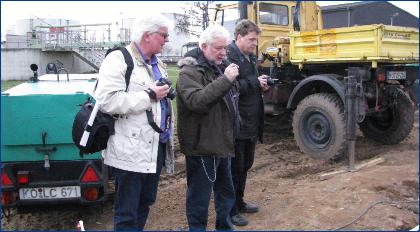Invitation to visit the „energy self-sufficient wastewater treatment plant“
Ladies and Gentlemen,
The City of Koblenz is well on the way to transforming their wastewater treatment plant so that the energy it requires is produced by the plant itself. Currently, a new sludge drying plant is being built at a cost of around € 2.5 million. In addition, a heat pipeline route will be built from the existing cogeneration plant to the sewage sludge dryer, which will cost around € 650,000.
On Thursday, 20 February at 15.30 hours, at the Koblenz Wastewater Treatment Works, Kammertsweg 82, the head of the building department, Martin Prümm, will make a presentation, during a site visit, on the measures that should make the sewage treatment plant independent of external energy supplies.
Experts from the Municipal Drainage Board will also be available to answer your questions.
We cordially invite you to this occasion and would welcome your coverage.
Kind regards, by order sgd Thomas Knaak
On its way to an energy self-sufficient wastewater treatment plant
(Koblenz: 21.02.14) The Koblenz Wastewater Treatment Works purifies the effluent from the City of Koblenz, from the Verbandsgemeinde (collective municipality) of Vallendar and from a sewage disposal association. The purity requirements have been tightened further in recent years. It also requires a considerable expenditure of energy to comply with all the required values.
Koblenz Municipal Drainage Board has been participating in the LIFE + EU-funded programme since 2010. In this way, the treatment plant is to be converted into a “self-sufficient operation.” With the construction of a sludge drying plant, a further step in this direction is now being made. The head of the building department, Martin Prümm, now presented the sludge drying plant and the pipeline route, which are both under construction, within budget and on schedule.
In the so-called digesters, the organic compounds in the sludge coming into the Wastewater Treatment Works are broken down. The digester gas formed during this process consists of 2/3 methane and 1/3 carbon dioxide. Due to its high calorific value of 25,000 to 30,000 kJ / Nm3, it is utilized in a cogeneration (CHP) plant, thus generating, on the one hand, the thermal energy needed for the drying and, on the other hand, the electrical energy for the rest of the Wastewater Treatment Works. Parallel to the EU project, the Koblenz Municipal Drainage Board is renewing the CHP plant dating from 1990. The 3 modules of 240 kWel, will be replaced by a new system with 3 modules of 300 kWel.
Before the sludge can be converted into energy, the water must be first be removed by drying. For the construction and delivery of the drying plant, the Koblenz Municipal Drainage Board launched an EU-wide invitation to tender in which the “Klein Technical Solutions GmbH” from Niederfischbach in the Rhineland-Palatinate emerged as the most favourable bidder. However, to bring the heat from the CHP plant to the dryer, a pipeline route must be established, which connects the two components. The Koblenz-based “Otto Pähler GmbH” won the tender for this. The commissioning date for all the subcomponents, the dryer with exhaust air treatment and storage silo, the pipeline route and the new low-voltage switchgear, is expected to be at the end of June.
The total cost of these subcomponents is approximately € 4 million.

